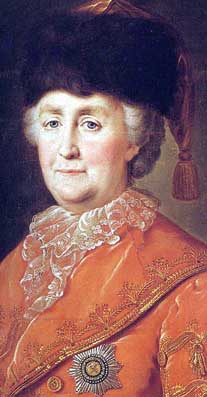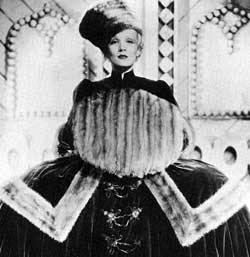Oksana Dykyj on why Catherine was great

Portrait of Catherine the Great
Oksana Dykyj, Head of Visual Media Resources, had a nearly full house for a recent Sunday afternoon talk at the Montreal Museum of Fine Arts.
That’s rare, Dykyj said, because the English-language talks usually get only half the audience of the French-language ones. It’s probably a testament to the popularity of the current show, Catherine the Great: Masterpieces from the State Hermitage Museum.
Dykyj talked about how Catherine has been portrayed in popular culture, from ads for vodka and perfume to a glamorous movie starring Marlene Dietrich.
Catherine was a German princess who married the czar of Russia. She stepped in as regent when her husband died, some say at her command. She became famous as a voracious art collector, a lover of many men, a decisive politician and a confident letter-writer to the French philosophes Diderot and Voltaire.

Marlene Dietrich as Catherine the Great in The Scarlet Empress, 1934
In “A Czar(ina) is Born: Catherine the Great, Cinema, Fashion and Theatre,” Dykyj gave her audience the pop culture Catherine. She was really a queen for all seasons, from Mae West’s risqué Broadway show, called Catherine Was Great, to a tepid made-for-TV movie in the 1990s that made the nuptials of the 18th-century czarina of Russia look like those of Princess Diana. Dykyj will give the same talk in French on March 26.
This was not the first bilingual lecture Dykyj has given at the MMFA. Her first was about post-Impressionist painter Edouard Vuillard and early 20th-century film. She gave talks last year on filmmaker-playwright Jean Cocteau and on furniture designer Émile-Jacques Ruhlmann.
“That one was my favourite, because one of my areas of research is art direction in film and my favorite period is the art deco and streamline moderne period of the 1920s to the 1940s,” she said.
“I’m doing two more lectures in May on design in Italian films from the 1920s to the 1960s in conjunction with the MMFA’s Italian design show.” She may also contribute to a coming show on Walt Disney.
Dykyj became involved with the museum in 2003 through Dominic Hardy, who works for the Education Department of the MMFA and is finishing a PhD in Art History at Concordia.
She graduated in Film Studies from Concordia. She got an MA in Cinema Studies from New York University and an MLIS (Masters’ in Library and Information Studies) from McGill. “I wanted to work with film in an archival/academic setting rather than going the academic route towards a PhD.”

Librarian and film historian Oksana Dykyj said, "I'm pleased that my theory about the extent of Catherine's celebrity is being supported by the popularity of the exhibition"
After some part-time teaching in Film Studies, she was asked to run Visual Media Resources at Concordia. It has migrated from the now-defunct Audio-Visual Department to IITS and now is part of the Fine Arts Faculty.
Concordia, and particularly the Fine Arts Faculty, has a mutually enriching relationship with the MMFA, with the Defiant Imagination lecture series by faculty members, frequent lectures by Canadian art expert François-Marc Gagnon and training for the museum’s volunteer guides through Continuing Education.
Dykyj, who also works with the Cinemathèque québécoise, prizes the synergy with other cultural institutions. “This symbiotic relationship is extremely valuable for all of us,” she said.